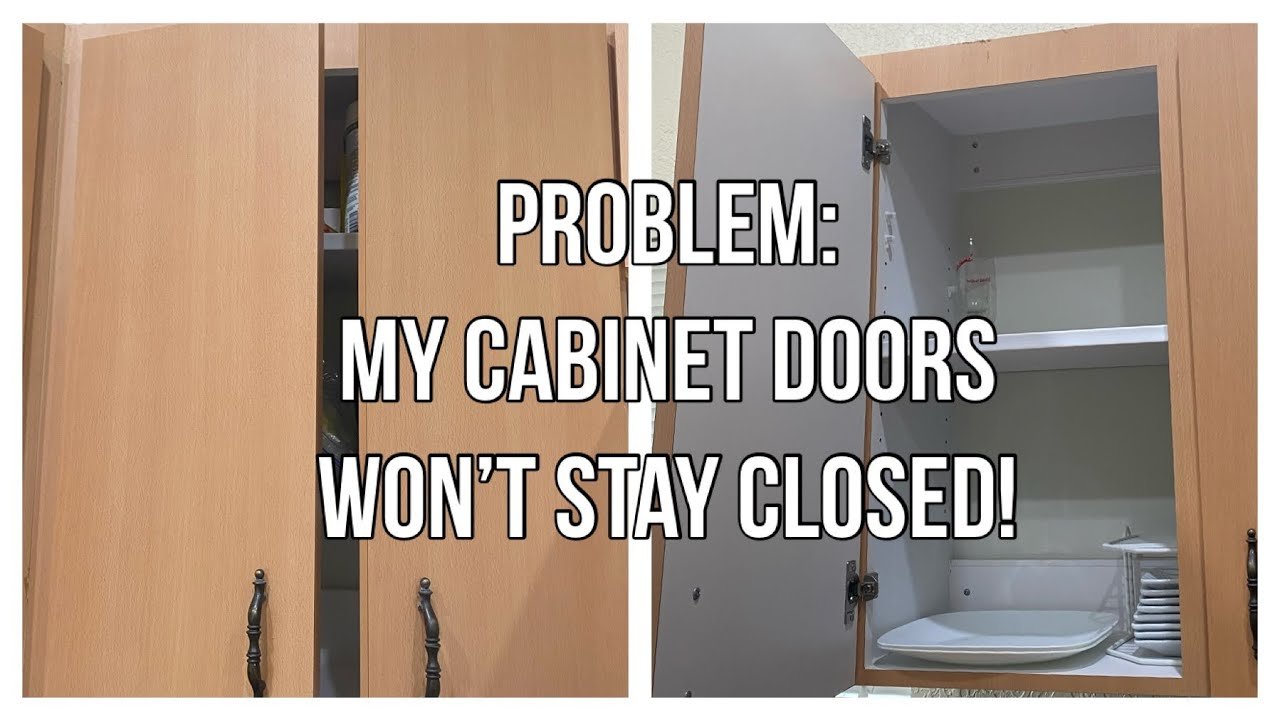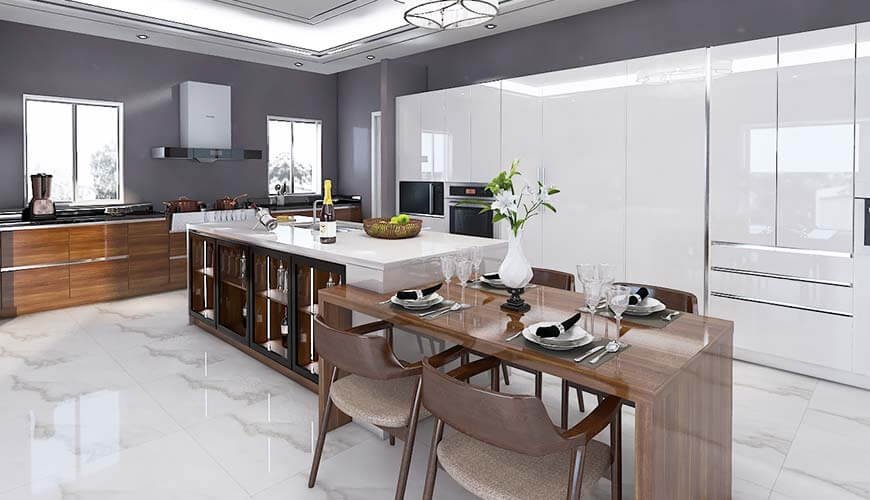Kitchen cabinet doors won’t stay closed due to misaligned hinges or worn-out magnetic catches. Fixing these issues can restore proper closure.
Kitchen cabinets are essential for storage and organization in any home. Cabinets that won’t stay closed can be frustrating and inefficient. Common causes include misaligned hinges, worn-out magnetic catches, or loose screws. Addressing these problems can improve the functionality and appearance of your kitchen.
Simple adjustments and replacements often solve the issue quickly. Regular maintenance can prevent future occurrences. By ensuring your cabinet doors function properly, you maintain a tidy and efficient kitchen space. Solving this problem not only enhances usability but also adds to your home’s overall appeal.
Table of Contents
ToggleCommon Causes
Kitchen cabinet doors that won’t stay closed can be frustrating. Understanding the common causes can help fix the problem easily. Two main issues often cause this annoyance: loose hinges and faulty magnets.
Loose Hinges
Loose hinges are a frequent cause of cabinet doors not closing properly. Over time, hinges can wear out or become loose.
- Regular use weakens the screws holding the hinges.
- Poor installation can also cause the hinges to misalign.
Checking the hinges can reveal if they are the problem. Use a screwdriver to tighten any loose screws. If the hinges are old, consider replacing them with new ones. Ensuring the hinges are secure helps the doors stay closed.
Faulty Magnets
Cabinet doors often use magnets to stay closed. Faulty magnets can cause the doors to pop open.
| Cause | Solution |
|---|---|
| Weak magnets | Replace with stronger magnets |
| Misaligned magnets | Realign or reinstall magnets |
Check the magnet strength by testing with a small metal object. If the magnet is weak, replace it with a new one. Ensure the magnets align correctly by adjusting their positions. Strong and well-placed magnets ensure the cabinet doors stay closed.
Tools Needed
Fixing kitchen cabinet doors that won’t stay closed requires some basic tools. Having the right tools makes the job easy. In this section, we will discuss the essential tools you need.
Screwdriver
A screwdriver is your primary tool. It helps in tightening or loosening screws. You may need both flathead and Phillips head screwdrivers. These will help you adjust hinges and other hardware.
- Flathead Screwdriver: Useful for flat screws and prying open hinges.
- Phillips Head Screwdriver: Ideal for cross-shaped screws.
Ensure you have the correct size. Using the wrong size can strip the screws. A stripped screw is hard to remove.
Magnetic Catch
A magnetic catch can solve many issues. It keeps the cabinet door closed with a magnet. You need to install it inside the cabinet.
- Choose a magnetic catch with strong hold.
- Install the magnet inside the cabinet.
- Place the metal plate on the door.
A table might help you choose the right magnetic catch:
| Type | Strength | Best For |
|---|---|---|
| Light Duty | 10-20 lbs | Small Cabinet Doors |
| Medium Duty | 20-40 lbs | Medium Cabinet Doors |
| Heavy Duty | 40-80 lbs | Large Cabinet Doors |
Magnetic catches are easy to install. They are effective for keeping doors shut.
Tightening Loose Hinges
Kitchen cabinet doors that won’t stay closed can be frustrating. Often, the problem lies in loose hinges. Tightening these hinges can solve the issue. Let’s explore how to do this step by step.
Identifying Loose Hinges
First, check if the hinges are loose. Open and close the door slowly. Listen for any creaking sounds. Use your hand to feel if the door wobbles. Look for any gaps between the door and the cabinet frame.
| Symptoms | Possible Cause |
|---|---|
| Door Wobbles | Loose Screws |
| Creaking Sounds | Hinges Need Tightening |
| Gaps Between Door and Frame | Misaligned Hinges |
Steps To Tighten
- Gather Tools: You need a screwdriver and a flashlight.
- Locate Screws: Use the flashlight to find the hinge screws.
- Tighten Screws: Turn the screwdriver clockwise to tighten each screw.
- Check Alignment: Close the door to check the alignment.
- Test Door: Open and close the door to ensure it stays closed.
These simple steps can fix your loose hinges. Tightening them helps your kitchen cabinet doors stay closed.

Replacing Worn Magnets
One common issue with kitchen cabinets is doors that won’t stay closed. This problem often results from worn magnets. Replacing these magnets can fix the issue, ensuring your kitchen remains functional and neat.
Choosing New Magnets
Selecting the right magnets is essential. Look for strong, durable magnets designed for cabinet doors. Measure the size of your current magnets. This ensures you buy the correct replacements.
Consider these factors when choosing new magnets:
- Strength: Strong magnets keep doors firmly closed.
- Size: Ensure the magnets fit the existing space.
- Material: Choose rust-resistant materials for longevity.
Installation Process
Follow these simple steps to install your new magnets:
- Remove the old magnets using a screwdriver.
- Clean the area to remove any debris or residue.
- Align the new magnets with the screw holes.
- Secure the magnets with screws. Ensure they are tight.
- Test the door to ensure it closes properly.
Below is a table summarizing the tools and materials needed:
| Tools | Materials |
|---|---|
| Screwdriver | New magnets |
| Cleaning cloth | Replacement screws (if needed) |
Replacing worn magnets is a simple and effective solution. It ensures your kitchen cabinets stay closed, keeping your space tidy.
Installing Magnetic Catches
Are your kitchen cabinet doors refusing to stay closed? Installing magnetic catches can be the perfect solution. These small yet powerful devices can keep your cabinet doors securely shut. Below, we’ll dive into the types of magnetic catches available and share some installation tips.
Types Of Catches
There are several types of magnetic catches to choose from:
- Surface-mounted catches: Easy to install and attach directly to the surface.
- Mortise catches: Installed within the cabinet door for a hidden look.
- Double magnetic catches: Ideal for larger doors needing extra holding strength.
Each type has its benefits. Surface-mounted catches are simple to install. Mortise catches offer a sleeker appearance. Double magnetic catches provide extra strength.
Installation Tips
Follow these tips for smooth installation:
- Gather your tools: drill, screws, and screwdriver.
- Mark the location: Ensure proper alignment with the cabinet door.
- Drill pilot holes: Prevent wood splitting by drilling small holes first.
- Attach the catch: Secure it with screws, ensuring it’s snug.
- Test the door: Open and close it to ensure proper alignment.
A table can help visualize the process:
| Step | Description |
|---|---|
| 1 | Gather your tools: drill, screws, screwdriver. |
| 2 | Mark the location: Ensure proper alignment with the cabinet door. |
| 3 | Drill pilot holes: Prevent wood splitting by drilling small holes first. |
| 4 | Attach the catch: Secure it with screws, ensuring it’s snug. |
| 5 | Test the door: Open and close it to ensure proper alignment. |
Magnetic catches can make a huge difference. They keep your kitchen looking tidy and organized. Happy fixing!
Adjusting Cabinet Alignment
Is your cabinet door refusing to stay shut? This common issue can be frustrating. The problem often lies with the cabinet’s alignment. Adjusting cabinet alignment can resolve this and bring back the functionality of your kitchen cabinets. Let’s dive into the steps to check and re-align your cabinet doors.
Checking Alignment
First, inspect the alignment of your cabinet doors. A simple visual check can reveal if the doors are uneven. Stand back and look at your cabinet doors. Do they appear crooked or misaligned? If yes, some adjustments are necessary.
Next, open the cabinet door and examine the hinges. Over time, hinges can become loose or worn out. Use a screwdriver to tighten any loose screws. This can solve minor alignment issues quickly.
Re-aligning Steps
If the visual check and tightening of screws didn’t help, follow these re-aligning steps:
- Loosen the screws on the hinges slightly, but do not remove them.
- Adjust the door so it aligns with the cabinet frame.
- Hold the door in place and tighten the screws.
- Check the door’s alignment again and make further adjustments if needed.
| Issue | Possible Solution |
|---|---|
| Door is too high or low | Adjust the top and bottom hinges |
| Door is too far left or right | Adjust the side hinges |
| Door is not closing properly | Check for obstructions or warped wood |
Ensuring your cabinet doors are properly aligned can prevent them from swinging open. This keeps your kitchen looking neat and organized. Regular maintenance can help avoid alignment issues in the future.
Using Adhesive Strips
Kitchen cabinet doors that won’t stay closed can be frustrating. Adhesive strips offer a simple solution to this problem. They are easy to use and inexpensive. This guide will help you choose and apply the right adhesive strips for your cabinets.
Types Of Strips
There are different types of adhesive strips available. Here are some common ones:
- Velcro Strips: These offer a strong hold and are reusable.
- Magnetic Strips: Ideal for heavier cabinet doors.
- Foam Strips: Provide a cushioned close and prevent slamming.
- Double-Sided Tape: Good for lightweight doors.
Application Method
Applying adhesive strips is straightforward. Follow these steps:
- Clean the Surface: Use a damp cloth to wipe the cabinet and door.
- Measure and Cut: Cut the strip to the needed length.
- Peel the Backing: Remove the protective backing from the strip.
- Press Firmly: Attach the strip to the door and frame. Press it firmly.
- Test the Door: Open and close the door to ensure it stays shut.
Adhesive strips can solve the issue of cabinet doors that won’t stay closed. Choose the right type and apply them correctly for best results.

Seeking Professional Help
Sometimes, kitchen cabinet doors just won’t stay closed despite your best efforts. In these instances, seeking professional help is the best solution. Hiring a professional can save time and ensure the job is done correctly. Below, we explore when to call a pro and how to choose the right service.
When To Call A Pro
Knowing when to call a professional can be tricky. Here are some signs:
- Doors are misaligned: If doors don’t line up, a pro can help.
- Hinges are loose or broken: Professionals have the right tools to fix this.
- Cabinet frames are damaged: Structural issues need expert hands.
- Repeated DIY failures: If DIY fixes don’t work, call a pro.
Choosing The Right Service
Selecting the right professional service is crucial. Here are some tips:
- Check reviews: Look for services with positive feedback.
- Ask for references: A reputable service will provide past clients’ contacts.
- Compare quotes: Get multiple quotes to find the best price.
- Verify credentials: Ensure the service is licensed and insured.
When choosing a service, it’s important to consider the pros and cons. Here’s a quick comparison:
| Criteria | Pros | Cons |
|---|---|---|
| Experience | High quality, quick solutions | May be more expensive |
| Price | Affordable options available | Cheaper may mean lower quality |
| Reputation | Trusted and reliable | May have long wait times |
Choosing the right service ensures your kitchen cabinets stay functional and look great. Always do your research and pick a service that meets your needs.

Frequently Asked Questions
Why Won’t My Kitchen Cabinet Doors Stay Closed?
Loose hinges or misaligned latches often cause this issue.
How Do I Fix Loose Cabinet Hinges?
Tighten screws or replace worn-out hinges for a secure fit.
What Are Common Reasons For Cabinet Doors Opening?
Misaligned latches, worn hinges, or warped doors can cause this problem.
Can I Use Magnetic Catches For Cabinets?
Yes, magnetic catches can help keep cabinet doors closed.
How Do I Adjust Cabinet Door Latches?
Align the latch with the strike plate and tighten the screws.
What Tools Are Needed To Fix Cabinet Doors?
You may need a screwdriver, drill, and replacement parts.
How Do I Know If Hinges Are Worn Out?
Check for rust, looseness, or difficulty in opening and closing.
Is It Difficult To Replace Cabinet Hinges?
No, it’s a simple process requiring basic tools and new hinges.
Can Warped Doors Be Fixed Easily?
Sometimes, but severe warping may require door replacement.
What Type Of Latch Is Best For Cabinets?
Magnetic or roller latches are effective for keeping doors closed.
Conclusion
Fixing kitchen cabinet doors that won’t stay closed is simpler than it seems. Addressing the issue promptly ensures a functional and tidy kitchen. Regular maintenance prevents future problems. Enjoy the benefits of a well-organized kitchen with secure cabinet doors. Follow these tips for lasting solutions and peace of mind.


